American View
Feature
Easing a Brutal Journey for Migrants in Arizona
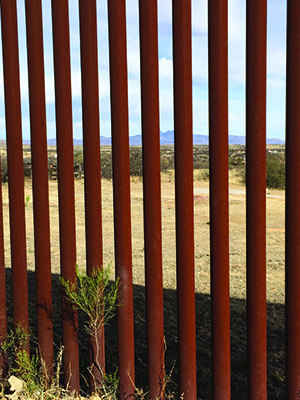
The border crossing at Sasabe, Arizona, lacks the bustle and bling of the crossings at Nogales and Tijuana. It’s a United States border patrol station incongruously plopped in the middle of the Sonoran Desert, a harsh landscape that freely spills across international borders.
Sasabe is one of the most desolate and least-used of all the border patrol stations. In stark contrast to the gleaming white, 1990s-era structure on American land, the station on the Mexican side is a dilapidated affair, strewn with wind-battered trash and souped-up search jeeps, rendered useless by multiple flat tires.
Cattle used to wander freely in this southernmost corner of Pima County, whose capital seat is Tucson. You can still see the remains of an empty wooden pen that once guided the steers as they moved from one grazing area to another. No longer. Over the course of 2007 and 2008, the United States Department of Homeland Security built an iron fence designed to block all human traffic across these borders, part of the sporadic wall system that designates the 2,100-mile border between the United States and Mexico.
I am here because freedom of movement is something I know about. In the mid-19th century, my father’s family moved from Olomouc, Moravia, now the Czech Republic, to Vienna, the capital of the Austro-Hungarian Empire. There they lived for nearly 100 years, decades as loyal subjects of Emperor Franz Josef, who in 1867 gave the Jewish community full rights as citizens.
But in 1938, five months after Germany’s annexation of Austria, known as the Anschluss, my father, then 29 and a partner with his father in a margarine factory, learned that his family, the Engels of the Sixth District, were on the SS’s deportation list. As he told the story, my father, Franz Engel (who later became Francis Elliott), went into his room and didn’t come out until he had devised an escape plan. The next day, the family fled Vienna in the dark of night—my father, his parents and his sister—slipping over the borders to Italy, Switzerland and, finally, France. After being interned for two years in an alien camp in central France, my father once again collected his family, eventually shepherding them to Lisbon, where they embarked for the United States.
My father, a reserved and largely unknowable man, rarely spoke of the trauma of his expulsion and subsequent flight. But I’m certain he felt his story had a happy ending. He escaped the inferno and years of displacement, settled into America, met and married my mother, got an advanced education, established a career and had a daughter. For the more than 20 years since his death, I have physically retraced his steps through Europe.
For the last two years, since my retirement, I have shifted my explorations to today’s displaced. Last October, I spent a week in Vienna volunteering on the frontlines of the current refugee crisis—meeting, greeting and helping in any way I could the vast wave of humanity flooding Europe from Syria, Afghanistan, Iraq and Iran. Now, at the age of 66, as I winter in Tucson, I am seeking out every possible migrant and refugee encounter. Wanting to help, wanting to understand, wanting to get to the heart of the matter.
It turns out that Arizona, a land of contrasts, is the ideal place for this journey. In many ways, Arizona is still the Wild West—stores and restaurants regularly display a picture of a gun with a slash through it, messaging “Don’t pack if you’re coming inside.” But one of the ironies in this state that started as a land grab from Native Americans is what seems to be profound respect for the rule of law. While most citizens here reject illegal migrants, Arizona has a long tradition of welcoming people fleeing crises in other parts of the world.
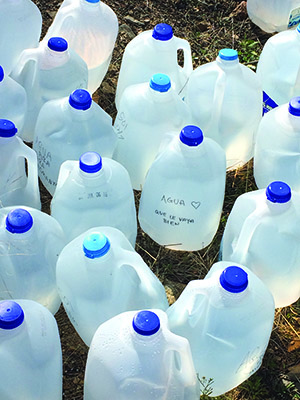
After Texas, California and New York, Arizona receives more refugees than any other state. According to the State Department’s Bureau of Population, Refugees and Migration, of the close to 70,000 refugees allowed into the country in fiscal year 2014-2015 from Iraq, the Democratic Republic of Congo, Somalia, Myanmar, Bhutan and elsewhere, 2,960 refugees were settled in Arizona, 598 of them in Tucson. Adding to the flow this year will be a trickle of Syrians.
The extremes of the Sonoran Desert have a dominant and prevailing influence over southern Arizona. It is not a picture-perfect, sand-duned desert, but more like the wilderness the Israelites sojourned through for 40 years after the Exodus from Egypt. There is scrub vegetation with lots of dirt, rocks and craggy mountains. Temperatures can dip way below freezing at night and soar into the 80s by day—and that’s just in winter. The biggest enemy of life in this wilderness are the elements. Those traveling by foot regularly die of dehydration, hypothermia/hyperthermia, sepsis from frostbite or infected, gangrenous foot blisters.
The Tucson sector of the United States-Mexican border is only 262 miles long. Still, it comprises the highest concentration of border patrol agents—with some 4,000, according to just-released figures from the United States government for last year. In addition, the area witnesses 20 percent of the total apprehensions of more than 63,000 illegal migrants and the second greatest number of desert deaths after the Rio Grande Valley sector in Texas. Fatalities in this part of the desert are so high—2,570 migrants died between January 1998 and May 2015, according to the most recent United States Customs and Border Protection Report—that record keepers use the abbreviation RHR, recovered human remains, to document the deaths.
During this same period, the population attempting to get over the border has changed. Initally, it was predominantly Mexicans seeking economic advantage in the United States; then it was Mexicans escaping gang violence and drug cartels. Most recently, Central Americans fleeing conflict—including unaccompanied minors—have been added to the mix. The one thing they all have in common is that they are entering the country illegally.
Horrified by the growing number of deaths in the desert, local activists, mostly church-based and veterans of the 1980s sanctuary movement—which gave safe haven to Central American refugees fleeing civil unrest—came together in the early 2000s to try to save lives. The Samaritans, a project of a local Presbyterian church, is one of the groups that formed at the time. Today, their members walk desert trails on a daily basis, looking for migrants in crisis. They leave water, food and blankets at predetermined GPS points, place commemorative crosses at spots where human remains are found and keep careful records so as to analyze migration trends and border patrol activity.
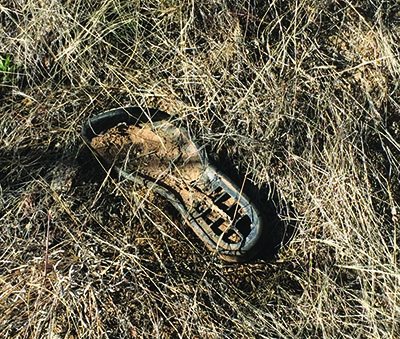
My first Samaritans trip takes place on a bone-chilling, drizzly winter day. Before going out with two other retirees, I attended a training that carefully laid out the legal framework by which we are able to carry out our mission. We learned that we are able to provide humanitarian aid—food, water and medical assistance—but are forbidden to abet an illegal in reaching his or her American destination.
I soon learn that the protocols for encountering illegals are mostly irrelevant, because they are nowhere in sight. This is a mixed bag. We are there to help, but how can we help those hidden from the naked eye? And if we do find some migrants, what will their condition be?
What we do end up finding that day is a spot where an illegal most likely came to the end of his journey. Strewn over a bush and nearby surroundings are men’s clothing, water bottles, a blanket and a pile of human excrement.
The blanket tips off my more experienced companions that there had been a border patrol apprehension and the person apprehended had most likely tossed aside his blanket knowing he wouldn’t need it in the detention center or back in Mexico. I am unsettled when I surmise that his loss of continence likely means he had been scared out of his mind.
When I recount the experience to a close friend who has lived in Arizona forever, she starts screaming: “Of course he was apprehended—he was an illegal!” I counter with, “When my father crossed the border from Austria to Italy, he was an illegal.” Empathy softens her features, but my argument fails to convince. Another friend, who moved here from the East, confesses that before coming here she had never felt the need to own a gun; now she and her husband keep one in their house. “We’re in a border state now,” she explains. “Things are different, and I’m scared.”
Borders are something legal refugees know about, too. To be a refugee in the United States, you have to have fled your homeland for a well-founded fear of persecution based on race, religion, nationality, ethnic background and/or political views. If you are among the fortunate few accepted in the program by the United Nations High Commissioner for Refugees, you undergo security and other vetting that can take 18 to 24 months—after which you can enter the United States.
Despite the daily influx of refugees in Tucson, I have personally encountered no deep-seated opposition to their presence. In fact, what the general population seems to lack in empathy for illegals contrasts starkly with the general welcome provided to the refugees. With so many individuals eager to volunteer, it can sometimes take weeks of waiting to mentor a refugee at one of the three resettlement agencies here. In addition, local churches have “adopted” entire families, providing everything from material aid to legal support.
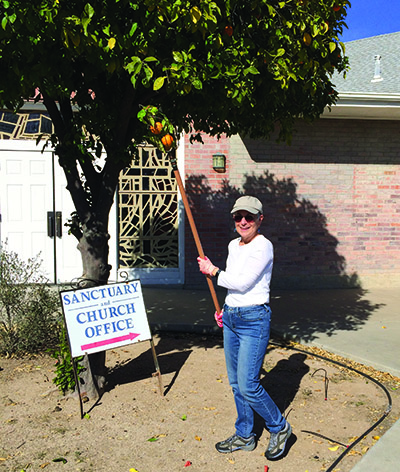
One of the most creative models of support can be found at an organization that intersects food justice with refugee assistance. In the early 2000s, Barbara Eiswerth, an environmental scientist and activist troubled by the thousands of citrus trees groaning with unused fruit in private backyards, at public institutions and in empty lots, got the brilliant idea to put refugees to work to help other refugees. She had them map the locations of the unattended citrus, olive and date palm trees, and then harvest the fruit.
Her nonprofit, Iskashitaa, which derives its name from the Somali Bantu word for “working cooperatively together,” was born. Over the years, the refugees have shared their knowledge of food sources through Iskashitaa workshops, where they demonstrate recipes from their native lands.
Today, refugees and locals harvest and glean together twice weekly. “Using food-based programming engages the refugees in the community,” Eiswerth tells me. “It’s so important for them to feel that they are contributing members of society while they are on their path to citizenship. The gift we get back from the refugees is that they bring other refugees to us.”
What began modestly 13 years ago has turned into a yearly avalanche of 50 tons of harvested citrus and other fruits and vegetables. On a late winter day, eight of us are dispatched to a retirement community north of Tucson, where we are assigned to harvest four orange trees. In less than an hour, with our long-handled harvesting tools, we contribute almost 60 pounds of oranges to this month’s harvest of five tons. The initial distribution goes to refugees, and the remainder is sent to food banks.
My partner is Alaa Al-Ani, 71, an Iraqi who arrived as a refugee in Tucson three years ago. Although our life experiences are worlds apart, there is an instant connection between us. A nonpracticing Muslim, he is proud that his family came from a small Iraqi town called Ana that boasts one of the Near East’s oldest synagogues. He tells me with obvious pleasure that his father even knew a few words of Hebrew from the many Jewish friends he had as a child.
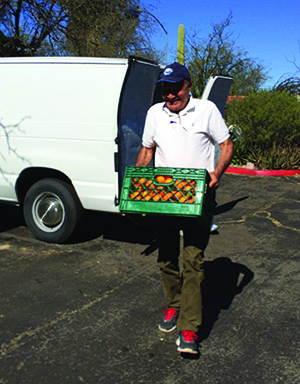
A highly educated retired civil engineer, he takes credit for introducing the traffic light and highway numbering system to Iraq. For much of his career, he was a consultant to American companies. In 1991, he was brought to Detroit by General Motors to help set up a GM plant in Iraq. That project was abruptly cut short by the outbreak of the first Gulf War. In the early 2000s, while consulting with an American high-tech company, he received death threats. Not wanting to become another statistic among the thousands murdered by radical elements, he tells me in halting English, he and his family escaped to Bahrain. Eight years later, they arrived in southern Arizona.
An extrovert with a sly sense of humor, he says that his favorite things in life are making friends, fishing and gardening. In Iraq, he had a large house, four cars and an expansive garden. Here, he lives with his wife and two of his unmarried sons in a house owned by his daughter and son-in-law, a difficult situation, he says, for a man not used to being dependent on others. He cultivates a small garden with a fig tree and other plants that remind him of home. “The first week I was here, I found Iskashitaa, and I have been volunteering ever since,” he says, explaining that gardening and harvesting have helped him put down roots in his new home.
That late winter morning, my harvesting partner and I are lucky. The sun is warm but not too hot, the air is fresh from recent rains and we have plenty of water to hydrate our bodies. As we reach for our bright orange targets, I can’t help but worry about the migrants not being found in the desert that day.
In one of my trainings with the Samaritans, I learned that humans living in desert environs metabolize more than 12 quarts of water a day. For those crossing the border from Mexico, there is at least a five-day journey by foot ahead of them—with no possible way to carry that kind of water. Every illegal migrant is in trouble before he or she even sets out. I also continue to wrestle with the distinction people in these parts make between legal refugees and illegal migrants.
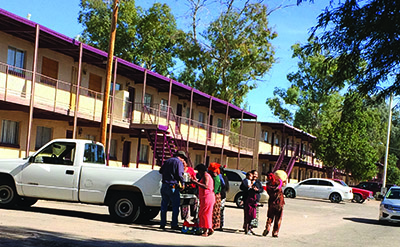
For me, there is no difference between them—on the face of it, they are all motivated by fear. Like the Israelites leaving Egypt, humans today do not abandon the land of their birth, cross the desert or attempt to reach the Promised Land unless they believe it is their only option for survival.
The legal differences between migrants and refugees should not govern compassion, especially for us Jews, who are repeatedly commanded to be kind to the stranger, because we were once strangers in Egypt.
The daughter of a refugee, I know the heart of the stranger better than most. But my own heart yearns to explore and understand not only my family’s path, but to own the ties that bind us all to the unknowable that sets individuals and peoples in danger on journeys to freedom.
Roberta Elliott is a former vice president for communications at HIAS, the Jewish refugee agency, and also served as the national public affairs director of Hadassah.








 Facebook
Facebook Instagram
Instagram Twitter
Twitter
Dr. Stephen Steinlight says
This is no more than an operation facilitating illegal immigration. It’s unsurprising that the author asserts that the “legal differences between migrants and refugees should not govern compassion.” But this merely shows contempt for the rule of law, the cement that holds nations together. Roberta Elliot has no right to pick and choose the laws she will uphold or violate. That same logic, made universal, would turn this country into an anarchic state. I’m also not surprised she was a former employee of HIAS, a “volunteer organization” that is NOT A CHARITY. It rakes in money by doing contract work for the Feds in supposedly “settling” refugees, though in reality they engage only briefly with them, dump them onto some municipality that is stuck with all the expenses of welfare, schooling, etc. And salaries for top staff are high. It should also be noted that HIAS has not helped many Hebrews in recent time: their specialty is importing Muslim “refugees,” the great majority who are not vetted by Intel, and dump them into places like Maine and the Twin Cities. This propaganda piece is shameful, not uplifting.
Michael Rosenkrantz says
It’s interesting to note where Dr. Steinlight is working, http://cis.org/. We are heading further and further towards Fascism and unless we take action and RESIST, the opinions of Dr. Steinlight and those at CIS will be the rule of law.
Melanie Roth Gorelick says
This is a beautiful and compassionately written article. The recognition of the struggle of the people who are seeking refugee and risk their lives to find safety and security from violent situations is important. It is only when we humanize refugees as people that it may become more compelling for our country to fix our broken immigration policies. We cannot ignore the plight of our neighbors. Nor the risk that these people put themselves through – especially the potential to be a Trafficked victim losing their freedom in a country where they may not speak the language and can easily be coerced and manipulated. It is a strong Jewish value to welcome the stranger – it does not ask where they come from.
Sheila Wilensky says
More than 11 million “illegal” immigrants live in our country’s shadows. Many of these human beings work for the rich and well-connected — illegally — as their nannies, gardeners, and in other capacities. Here in Arizona, right-wing politicians tried to legalize increased discrimination toward these shadow immigrants, many of whom have lived and worked in the United States their entire lives. This flawed Arizona legislation failed, partly because the 14th Amendment of the U.S. Constitution provides equal protection under the law. One may argue, does the 14th Amendment apply to anyone who came here “illegally?”Yes, it applies to all human beings who reside here, says this former U.S. history teacher.
“Ask me if I’m an immigrant” was the message I had inscribed on 1,000 buttons, which I distributed to individuals and organizations in Tucson. The truth is, we’re all immigrants, or the children of immigrants. Legal or illegal? Let’s finally create a path to citizenship for the millions of immigrants who have greatly contributed to our society.
Thanks to Roberta Elliot for this informative and well-written piece!
barb eiswerth says
Most immigrants without complete documentation are part of mixed documented families. That is to say their spouse, and or some of their children are documented and legally living in the USA. Do we really think ripping apart families is the solution to gigantic long term immigration issue? We welcomed for Europeans/English, then many others Italians, Polish, Germans, Russian, Bosnian, Hmong, then Bhutanese and Burundians now Afghani, Iraqi, and Congolese just to name a few.
Hamutal Gouri says
Thank you, Roberta, for a beautifully written piece.